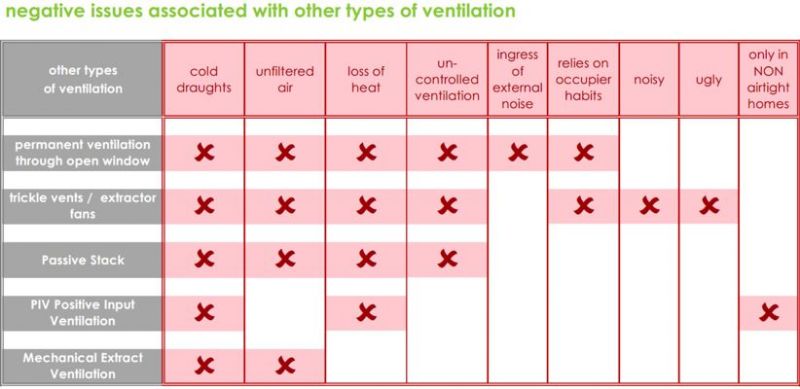heat recovery ventilation & heat pump ventilation (HRV/HPV) are so important for good indoor air quality
As you seal up and insulate your home more, so the indoor air quality
(IAQ) in your home deteriorates. Poorly sealed windows, doors and other
gaps are a thing of the past, as we try to save heat and energy. Our
homes therefore, can no longer breathe and the 'cling-film' effect
occurs creating bad indoor air quality.
The resulting rise in humidity increases not only mould growth, but also
the dustmite population, a worry for Asthma and allergy sufferers. High
humidity also increases the perceived temperature on hotter days
adversely affecting those in weaker health. Building fabric is damaged,
resulting in more expensive decoration costs and perhaps a lower market
value.
Did you know that a constant cocktail of chemicals is emitted from
everyday materials in your home? Chipboard, carpets, curtains,
laminates, paint, sofas and detergents are known to emit VOC's or
Volatile Organic Compounds which are posionous to your health.
And what about Radon Gas? It is a colourless, odourless gas that is made
from radioactive material and it naturally leaches out of the soil. In a
new-build property this won't be such an issue as you are likely to be
laying a
vapour membrane down on your ground floor. However, in a renovation or
retrofit, you may not be digging up your floors. This chemical could get
trapped within your home and it is the second biggest cause of lung
cancer in the UK. More information about Radon Gas can be found at https://www.ukradon.org/
Do you ever wake up after eight hours of sleep and not feel rested? Are
your eyes irritated or do you have a headache? Unfortunately it takes
less than an hour with two people
sleeping in a typical bedroom for them to breathe in enough carbon
dioxide from the air that they've expelled to induce these symptoms.
Outside there are about 300 parts per million (ppm) of Carbon Dioxide,
but dangerous levels of carbon dioxide will build-up in a room to over
1,000 ppm and cognitive ability will be adversely affected.
Add to this germs and micro-organisms and indoor air quality is often
worse than the air by a busy road! In Britain, we spend on average 90%
of our time indoors, with 70% of our time at home. We breathe over
10,000 litres of air a day, therefore continuous, controlled ventilation
is paramount within our lives.
To counteract these problems, traditionally, trickle vents in window
frames and individual extractor fans in bathrooms have been used.
However, these create drafts, cold spots, noise and significant heat
loss.
Adequate ventilation can contribute to over 50% of the total
heat losses in many modern homes. Therefore the potential for being more
energy efficient and saving on fuel bills, is high. This diagram
represents where heat energy escapes through the building envelope.
The biggest potential heat saving is evident in traditional
forms of ventilation. Below we have highlighted the weakness of
other forms of ventilation.

As you can see, all the above types of ventilation have one major flaw,
they allow cold air to seep into your house... heat
recovery ventilation and heat pump ventilation are the only systems that don't appear on this table...